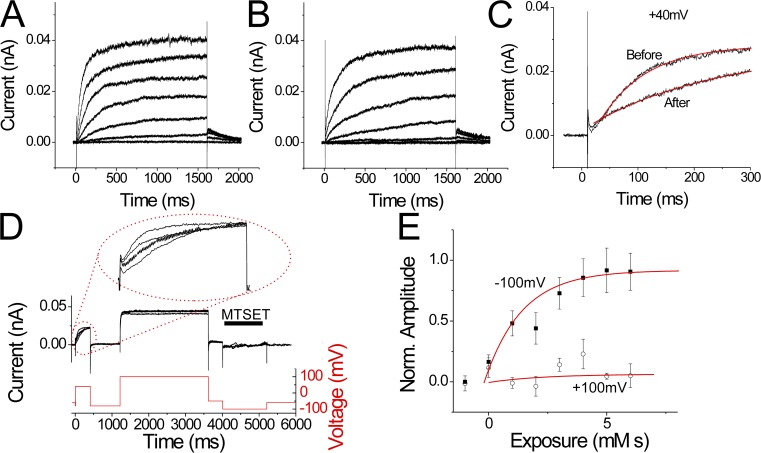Figure 6.
Internal MTSET modifies R258C channels only in the closed state. (A and B) Currents from an excised inside-out patch containing 258C channels in response to voltage steps from −60 to 60 mV, before (A) and after (B) application of internal MTSET (1 mM) for 10 s and washout for 10 s. The holding potential was −60 mV. (C) Currents in response to a voltage step to 40 mV before and after application of internal MTSET. The current time course was fitted with an exponential (red lines) with τ = 70 ms before MTSET and 220 ms after MTSET. (D) Currents from an excised inside-out patch containing R258C channels in response to sequential voltage steps to 40, 100, and −100 mV. Vholding = −80 mV. pHi = 5.5 and pHo = 7. 1 mM MTSET was applied for 1 s during the −100-mV voltage step. This protocol was repeated every 10 s for 10 times (only four traces are shown for clarity). The inset shows currents during the 40-mV voltage step, showing the slowing of the current time course in response to consecutive MTSET applications. (E) The rate of MTSET modification at −100 mV (closed boxes) or 100 mV (open circles) was measured by fitting the current time course during the 40-mV voltage step (from data like in panel D) to a double exponential with τ1 = 70 ms (unmodified channels) and τ2 = 220 ms (modified channels). The amplitude of the slower component is plotted versus the cumulative MTSET exposure. The amplitude of the slower component is assumed to be proportional to the number of MTSET-modified 258C channels. The data were fitted with an exponential to yield the second order rate constant k for the MTSET reaction with R258C. k = 630/M/s for MTSET applied at −100 mV. No significant modification was seen when MTSET was applied only at 100 mV. n = 7. Error bars are SEM.

